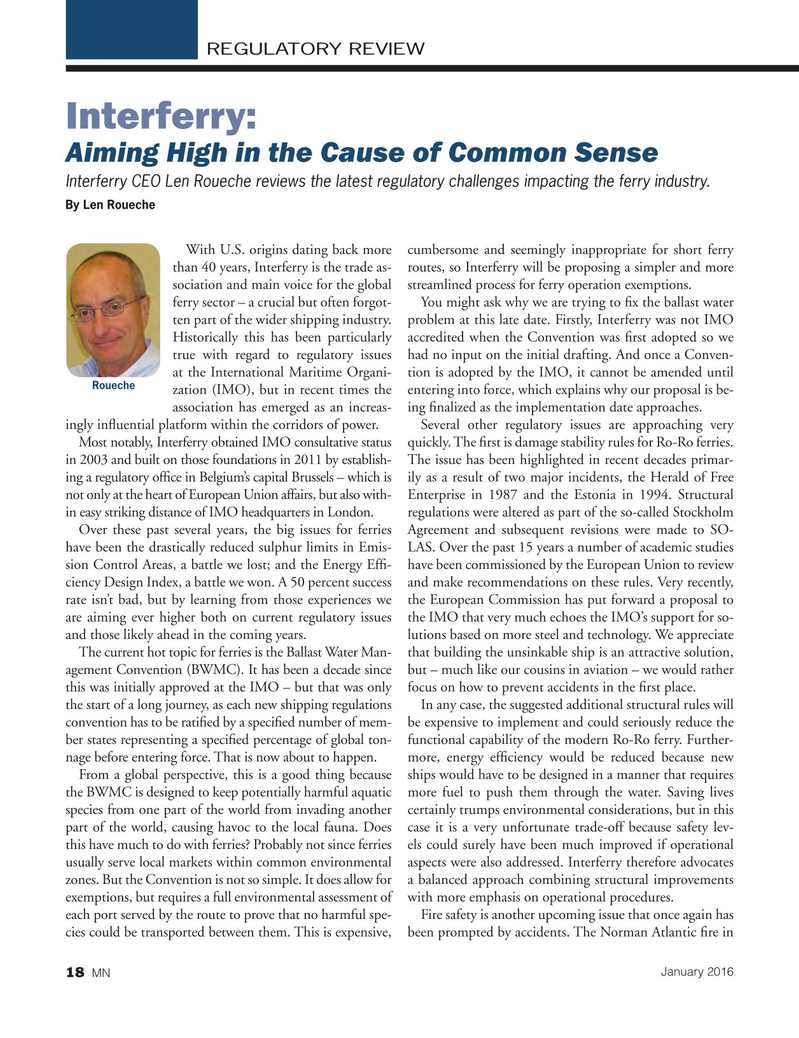
Page 18: of Marine News Magazine (January 2016)
Read this page in Pdf, Flash or Html5 edition of January 2016 Marine News Magazine
REGULATORY REVIEW
Interferry:
Aiming High in the Cause of Common Sense
Interferry CEO Len Roueche reviews the latest regulatory challenges impacting the ferry industry.
By Len Roueche
With U.S. origins dating back more cumbersome and seemingly inappropriate for short ferry than 40 years, Interferry is the trade as- routes, so Interferry will be proposing a simpler and more sociation and main voice for the global streamlined process for ferry operation exemptions. ferry sector – a crucial but often forgot- You might ask why we are trying to ? x the ballast water ten part of the wider shipping industry. problem at this late date. Firstly, Interferry was not IMO
Historically this has been particularly accredited when the Convention was ? rst adopted so we true with regard to regulatory issues had no input on the initial drafting. And once a Conven- at the International Maritime Organi- tion is adopted by the IMO, it cannot be amended until
Roueche zation (IMO), but in recent times the entering into force, which explains why our proposal is be- association has emerged as an increas- ing ? nalized as the implementation date approaches.
ingly in? uential platform within the corridors of power. Several other regulatory issues are approaching very
Most notably, Interferry obtained IMO consultative status quickly. The ? rst is damage stability rules for Ro-Ro ferries. in 2003 and built on those foundations in 2011 by establish- The issue has been highlighted in recent decades primar- ing a regulatory of? ce in Belgium’s capital Brussels – which is ily as a result of two major incidents, the Herald of Free not only at the heart of European Union affairs, but also with- Enterprise in 1987 and the Estonia in 1994. Structural in easy striking distance of IMO headquarters in London. regulations were altered as part of the so-called Stockholm
Over these past several years, the big issues for ferries Agreement and subsequent revisions were made to SO- have been the drastically reduced sulphur limits in Emis- LAS. Over the past 15 years a number of academic studies sion Control Areas, a battle we lost; and the Energy Ef? - have been commissioned by the European Union to review ciency Design Index, a battle we won. A 50 percent success and make recommendations on these rules. Very recently, rate isn’t bad, but by learning from those experiences we the European Commission has put forward a proposal to are aiming ever higher both on current regulatory issues the IMO that very much echoes the IMO’s support for so- and those likely ahead in the coming years. lutions based on more steel and technology. We appreciate
The current hot topic for ferries is the Ballast Water Man- that building the unsinkable ship is an attractive solution, agement Convention (BWMC). It has been a decade since but – much like our cousins in aviation – we would rather this was initially approved at the IMO – but that was only focus on how to prevent accidents in the ? rst place.
the start of a long journey, as each new shipping regulations In any case, the suggested additional structural rules will convention has to be rati? ed by a speci? ed number of mem- be expensive to implement and could seriously reduce the ber states representing a speci? ed percentage of global ton- functional capability of the modern Ro-Ro ferry. Further- nage before entering force. That is now about to happen. more, energy ef? ciency would be reduced because new
From a global perspective, this is a good thing because ships would have to be designed in a manner that requires the BWMC is designed to keep potentially harmful aquatic more fuel to push them through the water. Saving lives species from one part of the world from invading another certainly trumps environmental considerations, but in this part of the world, causing havoc to the local fauna. Does case it is a very unfortunate trade-off because safety lev- this have much to do with ferries? Probably not since ferries els could surely have been much improved if operational usually serve local markets within common environmental aspects were also addressed. Interferry therefore advocates zones. But the Convention is not so simple. It does allow for a balanced approach combining structural improvements exemptions, but requires a full environmental assessment of with more emphasis on operational procedures.
each port served by the route to prove that no harmful spe- Fire safety is another upcoming issue that once again has cies could be transported between them. This is expensive, been prompted by accidents. The Norman Atlantic ? re in
January 2016 18 MN
MN Jan16 Layout 18-31.indd 18 1/6/2016 2:45:50 PM

 17
17

 19
19
